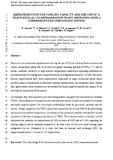Mostrar el registro sencillo del ítem
Improvements in the cooling capacity and the COP of a transcritical CO 2 refrigeration plant operating with a thermoelectric subcooling system
| dc.creator | Astrain Ulibarrena, David | es_ES |
| dc.creator | Merino Vicente, Amaya | es_ES |
| dc.creator | Catalán Ros, Leyre | es_ES |
| dc.creator | Aranguren Garacochea, Patricia | es_ES |
| dc.creator | Araiz Vega, Miguel | es_ES |
| dc.creator | Sánchez, Daniel | es_ES |
| dc.creator | Cabello, Ramón | es_ES |
| dc.creator | Llopis, R. | es_ES |
| dc.date.accessioned | 2020-01-27T09:50:34Z | |
| dc.date.available | 2021-06-05T23:00:13Z | |
| dc.date.issued | 2019 | |
| dc.identifier.issn | 1359-4311 | |
| dc.identifier.uri | https://hdl.handle.net/2454/36154 | |
| dc.description.abstract | Restrictive environmental regulations are driving the use of CO 2 as working fluid in commercial vapour compression plants due to its ultra-low global warming potential (GWP 100 = 1) and its natural condition. However, at high ambient temperatures transcritical operating conditions are commonly achieved causing low energy efficiencies in refrigeration facilities. To solve this issue, several improvements have been implemented, especially in large centralized plants where ejectors, parallel compressors or subcooler systems, among others, are frequently used. Despite their good results, these measures are not suitable for small-capacity systems due mainly to the cost and the complexity of the system. Accordingly, this work presents a new subcooling system equipped with thermoelectric modules (TESC), which thanks to its simplicity, low cost and easy control, results very suitable for medium and small capacity plants. The developed methodology finds the gas-cooler pressure and the electric voltage supplied to the TESC system that maximizes the overall COP of the plant taking into account the ambient temperature, the number of thermoelectric modules used and the thermal resistance of the heat exchangers included in the TESC. The obtained results reveal that, with 20 thermoelectric modules, an improvement of 20% in terms of COP and of 25.6% regarding the cooling capacity can be obtained compared to the base cycle of CO 2 of a small cooling plant refrigerated by air. Compared to a cycle that uses an internal heat exchanger IHX, the improvements reach 12.2% and 19.5% respectively. | en |
| dc.description.sponsorship | The authors would like to acknowledge the support of the Spanish Ministry of Science, Innovation and Universities for the funding under the FPU Program (FPU16/05203). | en |
| dc.format.extent | 34 p. | |
| dc.format.mimetype | application/pdf | en |
| dc.language.iso | eng | en |
| dc.publisher | Elsevier | en |
| dc.relation.ispartof | Applied Thermal Engineering, 155 (2019) 110-122 | en |
| dc.rights | © 2019 Elsevier Ltd. This manuscript version is made available under the CC-BY-NC-ND 4.0. | en |
| dc.rights.uri | http://creativecommons.org/licenses/by-nc-nd/4.0/ | |
| dc.subject | CO2 | en |
| dc.subject | Subcooling | en |
| dc.subject | R744 | en |
| dc.subject | Thermoelectricity | en |
| dc.subject | Transcritical | en |
| dc.subject | COP | en |
| dc.subject | Computational model | en |
| dc.title | Improvements in the cooling capacity and the COP of a transcritical CO 2 refrigeration plant operating with a thermoelectric subcooling system | en |
| dc.type | info:eu-repo/semantics/article | en |
| dc.type | Artículo / Artikulua | es |
| dc.contributor.department | Ingeniería | es_ES |
| dc.contributor.department | Ingeniaritza | eu |
| dc.contributor.department | Institute of Smart Cities - ISC | es_ES |
| dc.rights.accessRights | info:eu-repo/semantics/openAccess | en |
| dc.rights.accessRights | Acceso abierto / Sarbide irekia | es |
| dc.embargo.terms | 2021-06-05 | |
| dc.identifier.doi | 10.1016/j.applthermaleng.2019.03.123 | |
| dc.relation.publisherversion | https://doi.org/10.1016/j.applthermaleng.2019.03.123 | |
| dc.type.version | info:eu-repo/semantics/acceptedVersion | en |
| dc.type.version | Versión aceptada / Onetsi den bertsioa | es |



